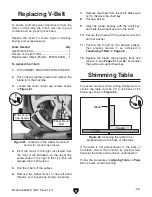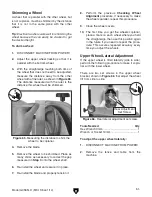
-36-
Model G0555LX
(Mfd. Since 1/14)
3. Pivot the motor so the upper cap screw slides
to the right of the slot. This releases the belt
tension.
4. Position the belt in the pulley grooves needed
(see
Figure 45) for the desired speed.
1800
FPM
Motor Pulley
Wheel Pulley
3100
FPM
Figure 45. Belt positions for different speeds.
5. Pivot the motor so the upper cap screw slides
left in the slot.
6. Apply pressure on the motor so there is
approximately
1
⁄
4
" V-belt deflection (see
Figure 46), then re-tighten the motor mount
cap screws.
7. Close the lower wheel cover before re-con-
necting the bandsaw to power.
Bandsaw
Wheel
1/4" Deflection
Motor
Wheel
Figure 46.
1
⁄
4
" V-belt deflection.
Blade Information
Selecting the right blade requires a knowledge
of the various blade characteristics to match the
blade with the particular cutting operation.
Blade Length
Measured by the circumference, blade lengths
are usually unique to the brand of your bandsaw
and the distance between wheels. Blades will
vary slightly even in the same length because of
how they are welded. Refer to the
Accessories
section later in this manual for blade replace-
ments from Grizzly.
Blade Width
Measured from the back of the blade to the tip of
the blade tooth (the widest point), blade width is
often the first consideration given to blade selec-
tion. Blade width dictates the largest and smallest
curve that can be cut, as well as how accurately it
can cut a straight line.
Always pick the size of blade that best suits your
application.
•
Curve Cutting: Use the chart in Figure 47 to
determine the correct blade for curve cutting.
Determine the smallest radius curve that will
be cut on your workpiece and use the corre-
sponding blade width.
Blade Width
Cutting Radius
Figure 47. Recommended cutting radius per
blade width.
Blade Dimensions
Length Range ............................................. 93
1
⁄
2
"
Width Range .............................................
1
⁄
8
"–
3
⁄
4
"
Содержание G0555LX
Страница 68: ......
















































